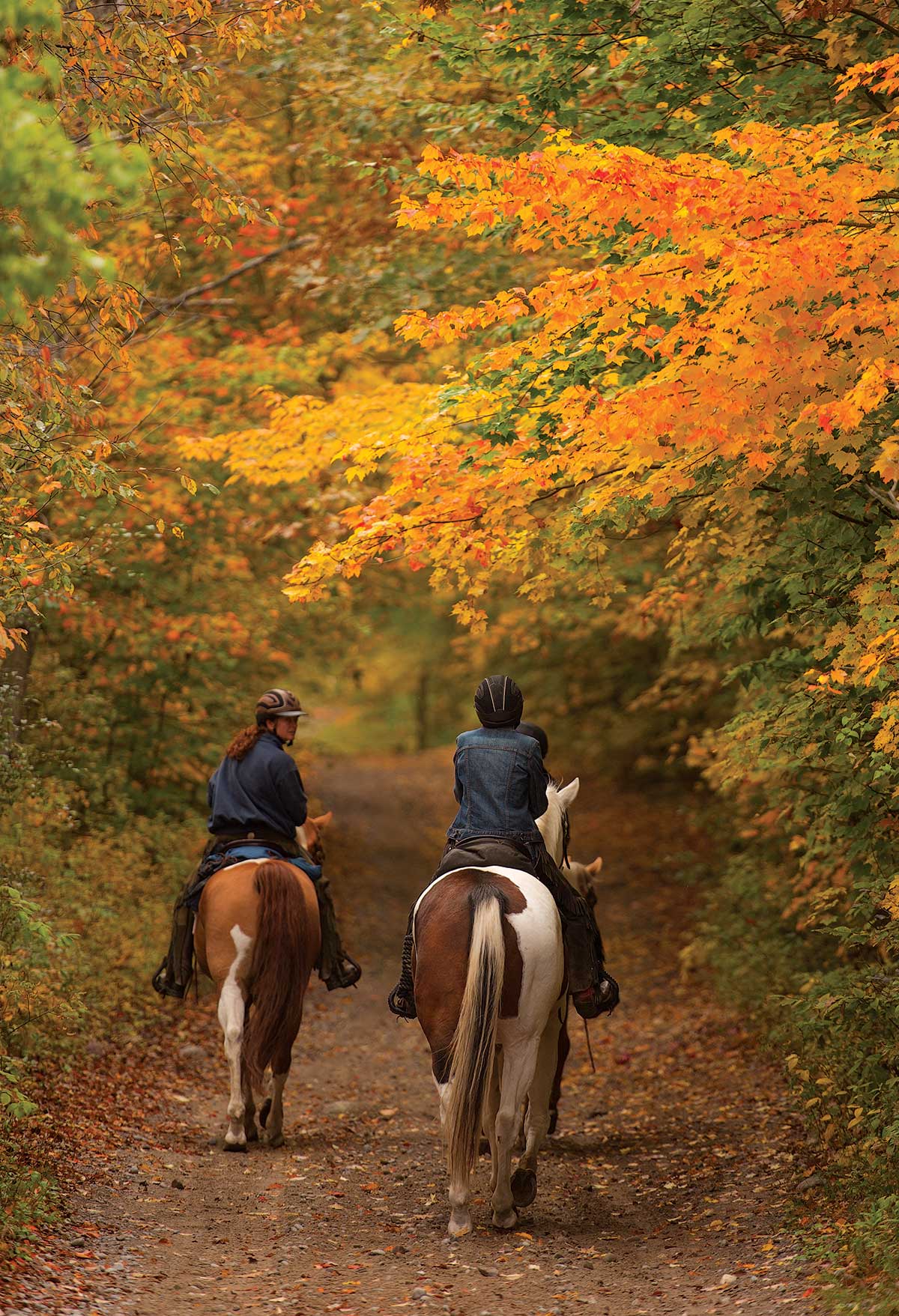
For trail riders, fall is a glorious time of year—crisp, cool weather, bright-blue skies, and trees bursting with autumn splendor. Here’s everything you need to plan your fall-color excursion, whether it be a day ride, an overnight adventure on your own horse, or an equestrian vacation at a farm or guest ranch. (For an exclusive listing of specific fall-riding destinations, equestrian vacations, and guest ranches, check out the Where-To-Ride Guide.)
Peak-Color Planning
Before you head out on a fall-riding adventure, find out when the leaves are expected to change color at your destination. Leaves turn color at different times, depending on the latitude, elevation, weather, and tree type. Check reports on the Web site for the park or national forest where you plan to ride, or contact the resort or outfitter you plan to visit.
To catch peak fall foliage, pinpoint an area where deciduous trees grow in large numbers. The phenomenon of fall foliage happens only in deciduous trees—trees that lose their leaves to survive the winter. The most colorful are certain species of aspen, oak, hickory, maple, birch, and poplar.
The time between when a leaf turns color and when it drops off the tree is relatively brief. Most trees don’t hold their colorful leaves for more than two weeks. A storm can knock the leaves from the trees prematurely, making the fall-color season particularly short.
Peak-color dates depend upon several factors, including the current temperature, and the previous seasons’ weather patterns. A warm, wet spring; a moderate summer; and a fall with warm, sunny days and cool nights make for the best fall colors. Drought can seriously affect the colors’ timing and vibrancy.
The higher the latitude, the earlier fall leaves change color. In New England and the upper Midwest, the leaves are typically at their peak color in middle to late September or early October, depending on the weather. In the central Midwest and Northeast, the middle of October usually shows the best colors. In the South and Southeast, the best colors appear in late October or early November. In the mountains of the West and Southwest, September and October offer the most vivid colors.
[READ: Keep Your Favorite Trails Open]
Coast-to-Coast Riding
Thanks to a combination of climate and flora, top fall-color regions in the contiguous United States offer an incredible opportunity to experience the best of autumn from the back of a horse. But even areas of the country less known for their fall foliage have regions where the trees give one last explosion of color before they drop their leaves for the winter.
Here’s an at-a-glance guide to fall color in six regions of the country.
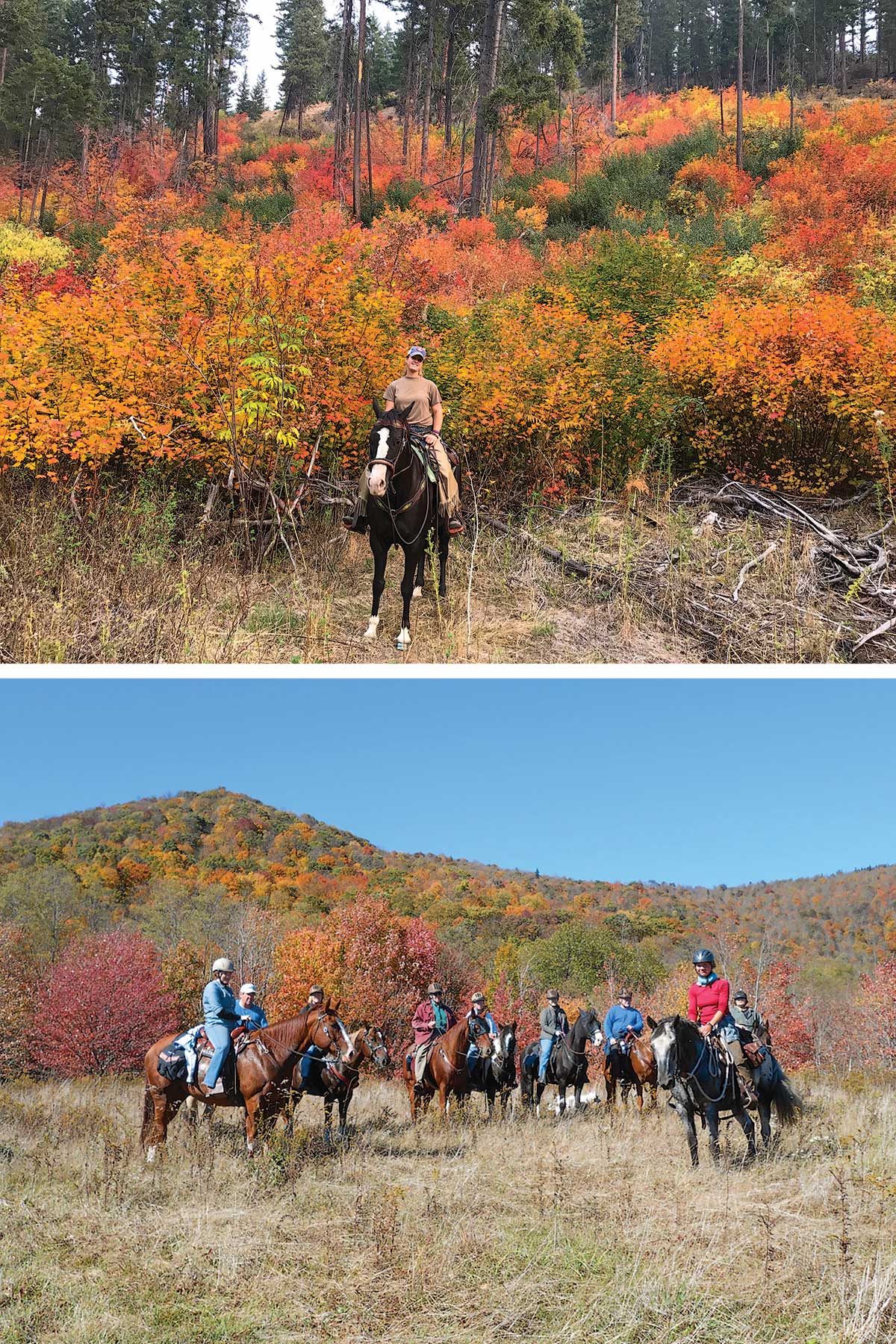
Pacific Region. While California, Nevada, Oregon, and Washington are known for their deserts and semi-arid regions, they also boast some of the most beautiful—and colorful—mountains in the country. The Sierra Nevada Mountain Range stretches some 400 miles north to south on California’s eastern side. The Carson Range spur lies primarily in Nevada. The Sierras offer aspen groves that glow yellow among evergreen forests in the fall. Pack stations take riders on multiday trips into the backcountry during the late spring, summer, and early fall. Guided day rides are also available through various outfitters in the Sierras out of Mammoth and Lake Tahoe.
Although Oregon is known for its evergreens, about one-third of the state’s trees are deciduous oaks, maples, alder, and larch. This makes for beautiful color from late September to early October. Silver Falls State Park, Mount Hood National Forest, and Wallowa-Whitman National Forest are among the best places to see Oregon’s rich fall colors.
Washington is renowned for its stunning mountains, and along with those beautiful peaks come great fall riding. At lower elevations, head to riding trails in Alpine Lake Wilderness, Colville National Forest, and Mount Spokane State Park.
“All of our trails are through the woods and have a vibrant show of fall colors,” says Erin Boyd, horse program manager for Mountain Springs Lodge in Leavenworth, Washington. “Vine maples are prominent in our woods and have a vibrant show of yellow, red, and orange as they change colors. The contrast of the evergreens alongside the vibrant fall colors is breathtaking. The mild weather and amazing fall colors make it my absolute favorite time of year to ride.”
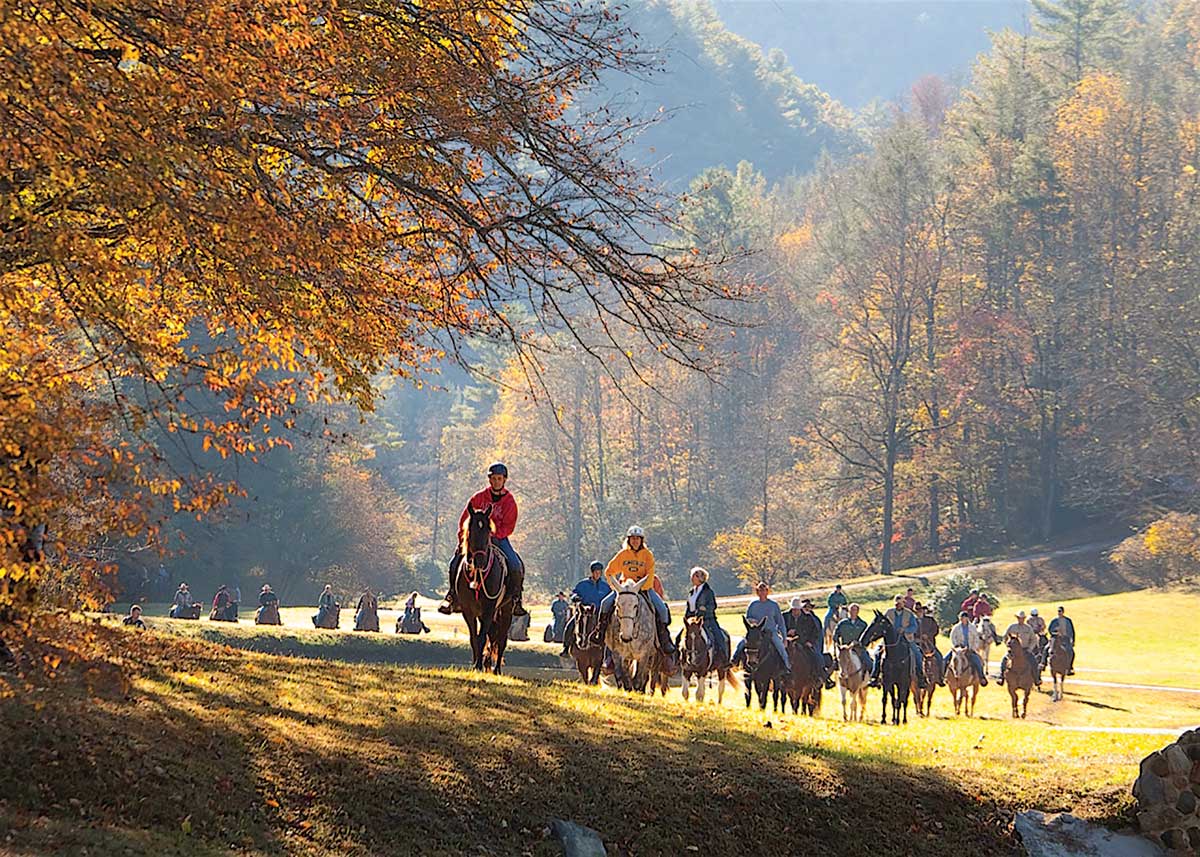
Southwest Region. Known mostly for its desert terrain, the Southwest actually provides many opportunities to see fall color on horseback. Mountainous regions in northern New Mexico, Utah, and Arizona are home to aspen and other deciduous trees that put on a show every autumn.
“We have oak and aspen trees that change colors during the fall,” says MaKenzee Reynold of High Mountain Trail Rides in Mormon Lake, Arizona. “Our rides go through the Coconino Forest, where we get beautiful color and cooler weather.”
In New Mexico, take in fall scenery in the Sandia Mountains just outside Albuquerque and the Sangre de Cristo Mountains near Santa Fe. In Utah, the Uinta and Dixie national forests offer riding trails that wind through a sea of fall colors.
Rocky Mountain Region. The Rockies are amazing all year, but they reserve their most colorful time for the fall. Aspen trees put on the biggest show, ranging from yellow, orange, and red, all with impressive mountain peaks as a backdrop.
“Fall is a spectacular time of year out here,” says Jenn Lynch of Fantasy Ranch Horseback Adventures in Crested Butte, Colorado. “We’re blessed with warm sunshine that makes 50 degrees feel like 70 at our altitude of 9,000 feet.”
Fantasy Ranch offers treks that give riders views of golden aspen trees, meadows of late-season wildflowers, and bubbling creeks. The Wyoming Rockies are also a great place to take in the mountain scenery rich with fall colors.
“We have one ride during early September, the Fall Color Ride, which catches the beginning of the quaking aspens and the willows changing colors,” says Bobbi Wade, co-owner of Blue Sky Sage Horseback Adventures in Big Piney, Wyoming. “Wyoming has glorious days in September, with temperatures usually in the upper 60s to low 70s in the day, cooling down to a little frost overnight, in the upper 20s.”
Midwest Region. The deciduous forests in our nation’s heartland reveal glorious colors from late September to mid-October, depending on where you ride. Maples, aspen, oak, and tamarack are among the trees that turn a variety of red, yellow, and orange.
National forests offer trails through gorgeous fall-foliage areas. Top riding trails wind through the Chequamegon and Nicolet in Wisconsin, the Chippewa and Superior in Minnesota, the Ottawa and Hiawatha in upper Michigan, the Willamette in Ohio, and the Shawnee in Illinois.
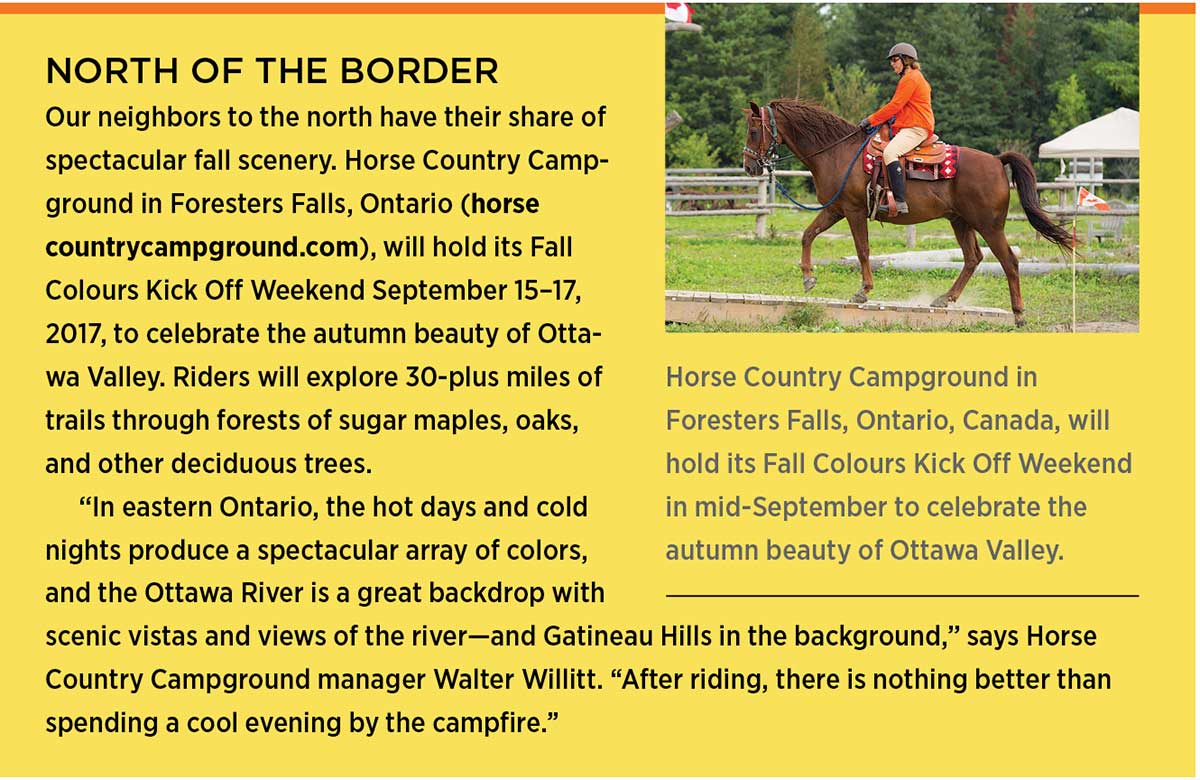
South/Southeast Region. For fall-foliage riding later in the season, the southern part of our country has plenty to offer. In West Virginia, the Allegheny Mountains provide one of the most striking backdrops for riding in the region.
“Here, there are 26 intersecting trails of backcountry terrain, with a lot of diversity,” says Ashley Peacock, farm manager for Shalimar Farm, in Cass, West Virginia, which offers guided trail rides to horse owners. “The scenery is stunning, and the fall colors are vibrant and plentiful.”
Just to the southeast, North Carolina is home to the Blue Ridge Mountains, where fall foliage is at its peak from the middle of October to late October.
“The Blue Ridge Mountains are famous for the amazing fall colors that grace our beautiful ridges and valleys,” says Abbie Hanchey, manager of Leatherwood Mountain Resort in Ferguson, North Carolina. “The trail system that is intertwined throughout our resort has been dubbed some of the greatest riding in the Southeast. The beautiful trails skirt high ridges and wind along mountain streams that are as beautiful as they are pristine.”
Northeast/Mid-Atlantic Region. New England and the states the lie just south boast some of the most spectacular leaf-peeping opportunities in the United States. With forests made up primarily of oak and maple, leaves turn color here in early fall, putting on a show that draws visitors from around the country.
“Guests at our ranch trek out from the inn and wind through pastures, forest, and 11 acres of 200-year-old sugar maple stands along the Saco River, all with panoramic mountain views,” says Charlene Browne, manager of Farm by the River Bed and Breakfast in North Conway, New Hampshire. “What a kaleidoscope of fall crimson color!”
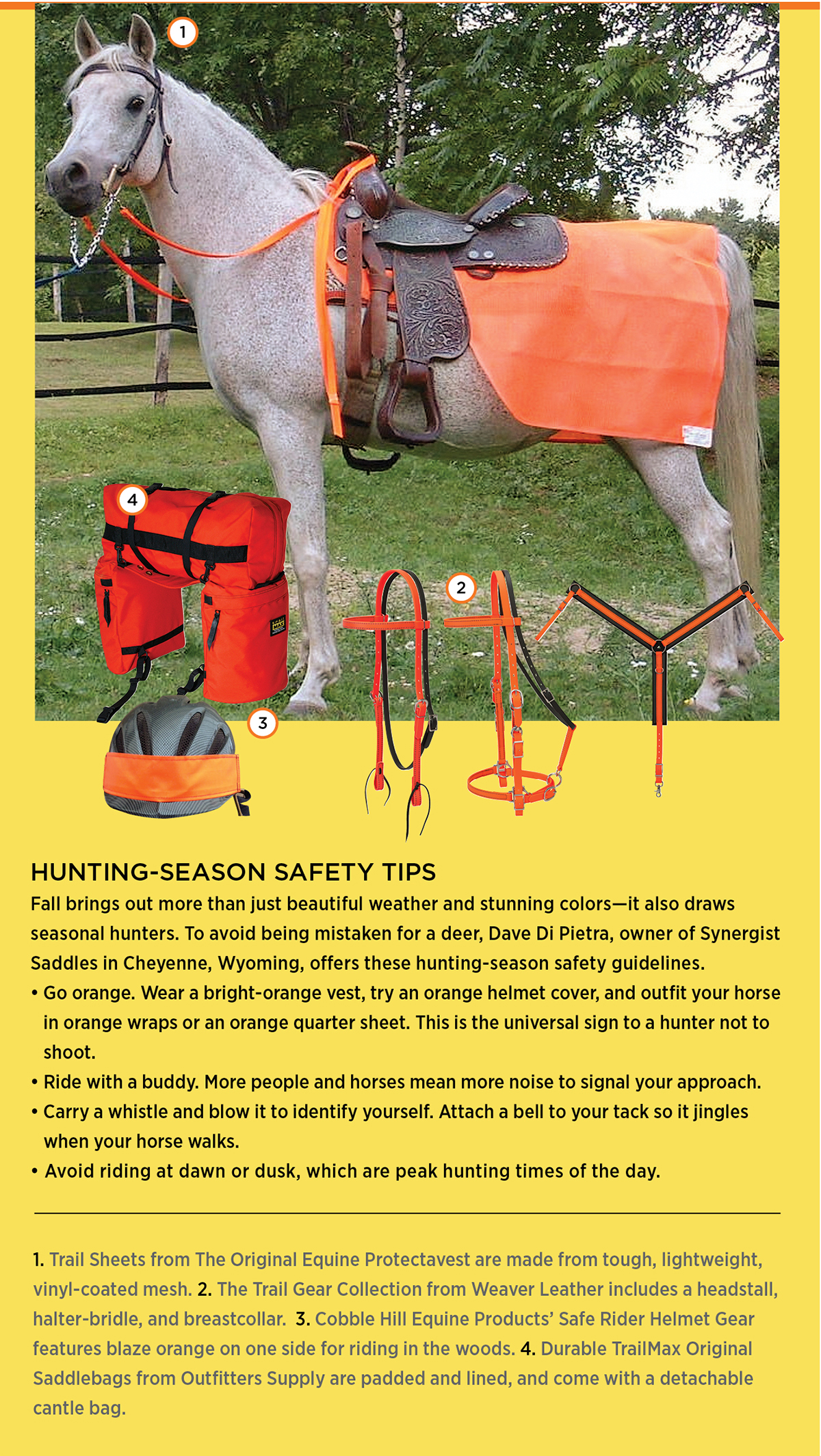
On-Trail Safety Tips
Trail-riding safety is important all year, but fall offers its own unique challenges. Here are some tips to keep in mind.
Consider tack and gear. Ride with loop reins, rather than split reins, to decrease the chance that you’ll drop a rein while riding. Accustom your horse to the feel of pommel and cantle bags, so he’ll calmly carry your rain slicker and gear.
Practice trail etiquette. Riding in the fall means basking in nature’s beauty, but it may also mean sharing the trails with other trail users. Ask mountain bikers to slow down or walk their bikes as they pass you. Request that hikers step off the trail so you can pass. Be aware, too, that your horse might be frightened by backpackers—he might not be able to make sense of a human with a large pack on her back. If your horse starts to panic, ask the backpacker to stop and speak. Often, hearing a human voice come from the “monster” will help a horse realize there’s nothing to fear.
Go slowly. One of the prettiest parts of the fall scenery is a trail blanketed with colorful leaves. The downside of those fallen leaves is that they can make the trail slippery—especially if they’re wet. Keep your pace slow when walking on leaf-covered trails.
Photograph with care. You’ll likely want to capture the beauty of your fall ride. Only do so on a well-trained, quiet, reliable mount.






